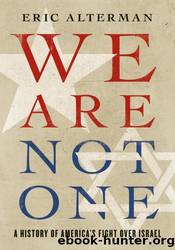We Are Not One by Eric Alterman

Author:Eric Alterman [Alterman, Eric]
Language: eng
Format: epub
Published: 2022-11-23T00:00:00+00:00
CHAPTER 14
DISCOURSE MATTERS
WHEN BILL CLINTON WON THE 1992 PRESIDENTIAL ELECTION WITH A whopping 80 percent of the Jewish vote, it provided him with a kind of permission to aggressively pursue a peace agenda that asked far more of Israel than any previous president had. It appeared to work for a while. Yitzhak Rabin and Yasser Arafat met on the White House lawn on a beautiful mid-September afternoon in 1993, shook hands, and signed the Oslo I Accord, named after the city in Norway where the negotiations for the peace agreement began. Countless Jewish tears were shed on the White House lawn that day, your authorâs included, when, during his speech, the usually blunt, unsentimental ex-general, Rabinâhe of the âmight, power, beatingsâ order during the First Intifadaâcried out to the Palestinian people, âWe say to you today in a loud and a clear voice: Enough of blood and tears. Enough. We have no desire for revenge. We harbor no hatred towards you. We, like you, are people who want to build a home, to plant a tree, to love, to live side by side with you in dignity, in empathy, as human beings.â Oslo II, signed two years later, would supplement Oslo I (together they are known as the âOslo Accordsâ). To those assembled, Rabin spoke words that sounded as if they could have fallen out of the Old Testament. One could be forgiven for believing that it was all taking place inside a dream. In a way, it was: one that lasted roughly seven yearsâand cost Rabin his lifeâbefore the world woke up to a reality of Palestinian terrorism, asymmetric Israeli military retaliation, a return to power of Israelâs right wing, and never-ending fusillades of accusation and recrimination from all sides during the final days of the second Clinton administration.1
In Israel, the philosopher and scholar of Hebrew literature Menachem Brinker was in the process of concluding that âthe task of Zionism is very nearly completed. That is to say, the problem that Zionism set out to address is just about solved. Soon we will be living in a post-Zionist era, and there will no longer be a good reason for a Zionist movement to exist alongside the State of Israel.â Given the central role that the movement had played in the creation of American Jewsâ identity, this presumed a radical reorientation that few, if any, were now prepared to accept. With the traditional agenda apparently a thing of the past, American Jewish leaders turned inward. The 1990â1991 National Jewish Population Study had shocked them with the finding that each year, more than half of the American Jews who got married were marrying gentilesâand these marriages rarely resulted in children who considered themselves to be members of the Jewish community. (The 1957 figure had been 3.5 percent.) This news caused panic among Jewish leaders and moved them to recommit themselves to prioritizing a âJewish continuity agendaâ that had been brewing for nearly four decades. (Both Commentary and Look, as early as 1963 and 1964, respectively, had claimed that Jews in America were âvanishing.
Download
This site does not store any files on its server. We only index and link to content provided by other sites. Please contact the content providers to delete copyright contents if any and email us, we'll remove relevant links or contents immediately.
| Arms Control | Diplomacy |
| Security | Trades & Tariffs |
| Treaties | African |
| Asian | Australian & Oceanian |
| Canadian | Caribbean & Latin American |
| European | Middle Eastern |
| Russian & Former Soviet Union |
The Secret History by Donna Tartt(18697)
The Social Justice Warrior Handbook by Lisa De Pasquale(12069)
Thirteen Reasons Why by Jay Asher(8718)
This Is How You Lose Her by Junot Diaz(6690)
Weapons of Math Destruction by Cathy O'Neil(6069)
Zero to One by Peter Thiel(5622)
Beartown by Fredrik Backman(5533)
The Myth of the Strong Leader by Archie Brown(5358)
The Fire Next Time by James Baldwin(5185)
How Democracies Die by Steven Levitsky & Daniel Ziblatt(5083)
Promise Me, Dad by Joe Biden(5029)
Stone's Rules by Roger Stone(4981)
100 Deadly Skills by Clint Emerson(4785)
A Higher Loyalty: Truth, Lies, and Leadership by James Comey(4768)
Rise and Kill First by Ronen Bergman(4643)
Secrecy World by Jake Bernstein(4584)
The David Icke Guide to the Global Conspiracy (and how to end it) by David Icke(4539)
The Farm by Tom Rob Smith(4397)
The Doomsday Machine by Daniel Ellsberg(4366)
